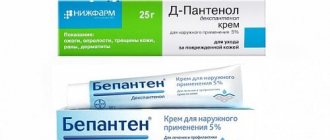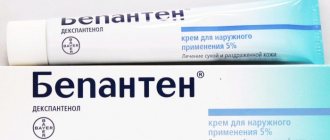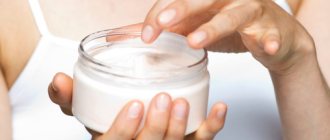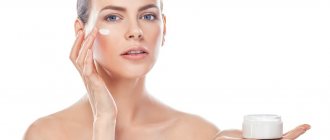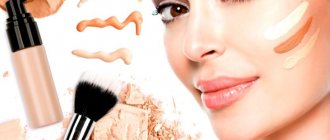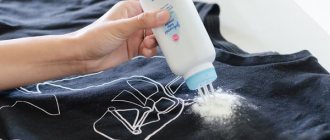- Oil
- Folk remedies
- Care and treatment
Children's skin is different from adult skin: it is thinner and not as resistant to external influences, so it requires special care. But even if you care for your baby’s skin correctly, diaper rash may appear on it - areas of inflammation in areas of contact with moisture and friction with diapers or diapers. To prevent the appearance of diaper rash or speed up its healing, avoiding infectious complications, special means are required1.
Diaper rash ointment
Ointments contain active ingredients that suppress inflammation and restore the skin. They also have a fatty base (for example, lanolin), which helps the active substance penetrate deep into the skin and creates a protective layer on its surface. All ointments are fatty and have a dense consistency, so they provide long-term contact with the active ingredient and reduce skin friction with a diaper or diaper. Thanks to these properties, using ointments can both cure diaper rash and prevent its occurrence2.
An example of a reliable baby ointment for diaper rash is Bepanten ointment, which contains provitamin B5 and lanolin in high concentration3. Provitamin B5, penetrating into the deep layers of the skin, quickly turns into vitamin B5 (pantothenic acid). It stimulates cell division, ensuring rapid healing of damage and fighting inflammation, and strengthens collagen fibers - the main component of the skin4. Lanolin serves as a conductor of provitamin B5 into the skin5 and forms a layer on its surface that prevents contact with moisture, and under the diaper - the irritating effect of feces and urine. One of the important properties of lanolin, unlike petroleum jelly, is its ability to create a breathable layer that does not interfere with air exchange, which is extremely important for the baby’s incompletely formed skin. The natural hypoallergenic composition with a proven high safety profile allows Bepanten ointment to be used for the treatment of diaper rash even in newborns and premature babies6.
Treatment for common diaper irritation
Diaper dermatitis, caused by constant skin contact with toxins and non-breathable material, is treated with special ointments and creams to restore the epidermis. These are creams containing panthenol, vitamins, oils and other components that are beneficial and safe for the skin, eliminating itching and redness.
Doctors also recommend changing diapers as often as possible to prevent prolonged skin contact with ammonia and uric acid. In addition, you need to give your child air baths several times every day. When the house is warm, the baby should be without clothes more often. During such procedures, the crib can be covered with an absorbent diaper and covered with cotton cloth.
Parents often ask pediatricians which diapers do not cause irritation. This question cannot be answered unambiguously, since children can react differently to the components used in diapers. Allergies can be caused by any component: most often such problems arise from diapers with fragrances or chamomile.
If your child's skin is prone to irritation, you need to buy high-quality diapers with a good absorbent layer. However, a particular brand of diaper may not be suitable for your child. Then try different options and find the optimal one.
Baby diaper rash cream
Baby diaper rash creams differ from ointments in having a lighter texture, as they are an emulsion of oil and water. They are absorbed faster, but do not have such a strong and long-lasting effect, although they often contain the same substances as ointments. Therefore, children's cosmetic creams are usually used to prevent diaper rash, and they are sold in stores, while ointments for babies can usually only be purchased in pharmacies.
Diaper rash creams for babies moisturize the skin, making it more resistant to the irritating effects of moisture and ammonia found in urine and feces. For healthy skin, such protection is quite enough, but in case of damage and signs of inflammation, the cream is replaced with ointment7.
How to treat infectious dermatitis
If the rash is caused by a bacterial infection, antibiotic ointments are used to treat diaper irritation. It is recommended to wipe the skin with antiseptic solutions. Internal antibiotics are prescribed only in the most severe cases, when the child has a fever or the rash spreads very quickly. As a rule, it is better not to use diapers at all during therapy.
Remember that for bacterial infections you cannot choose antibiotic medications on your own. This is dangerous for the child's health. Only the attending physician should select and prescribe medications, as well as determine the duration of the course.
Powder8
Powders are powdery products primarily based on talc and starch. Their main function is to absorb moisture, contact with which provokes skin inflammation. Most powders are intended to prevent diaper rash, but sometimes medicinal herbal extracts, anti-inflammatory or antibacterial components are added to them. In this case, they are also used to treat skin diseases. The powder is used morning and evening, applying it in a thin layer to clean, dry skin; if necessary, apply more often.
Recently, the advisability of powders has been discussed by pediatricians due to the high probability of their inhalation by the baby9. In addition, the powder collects deep in the folds, not providing reliable protection for the entire surface of the skin. It is increasingly recommended to replace powders with ointments that reliably protect the skin10. When using cream and powder at the same time, be aware that the talc may absorb water from the cream, and both products will not work.
Oil
Oils are often used to care for baby’s skin: they moisturize and nourish it, and promote wound healing. Vaseline oil or various types of vegetable oils (olive, fir, sea buckthorn) are suitable for children. The oils are boiled for 15 minutes in a water bath, then cooled to room temperature and applied to the skin11. Vaseline oil is considered hypoallergenic; allergic reactions to vegetable oils are possible12.
Oils are recommended to be applied to dry skin. If it is inflamed or liquid (exudate) forms on its surface, then the oil can slow down healing - a fatty film that delays air exchange will prevent the discharge from evaporating. It is undesirable to use oils for infectious complications, since microbes and fungi under the oil layer multiply even more actively. But the oil is good for moisturizing dry skin and helps restore it faster13.
Diaper irritation symptoms
Characteristic diaper rash appears in places where the skin comes into contact with diapers. Most often these are the buttocks, genital area and inner thighs. You can see what irritation from diapers looks like in the photo.
The main symptoms of diaper irritation on the bottom include the following:
- the skin is red;
- Peeling began in areas of diaper rash;
- in the area of redness, slight swelling and swelling are noticeable;
- small blisters and rashes appeared on the reddened skin;
- If left untreated, the skin may become covered with ulcers and wounds and become infected.
With such skin problems, babies often become whiny, capricious and lethargic. In some cases, the temperature may even rise.
Please note that if the irritation has spread beyond the area in contact with the diapers, then it is no longer diaper dermatitis, but a serious allergy or other disease. In any case, you should contact your pediatrician as soon as possible.
Folk remedies14
There are numerous traditional medicine recipes for the treatment and prevention of diaper rash:
- Infusion of bay leaves, decoctions of oak bark, string, chamomile are used for rubbing and compresses for diaper rash, and added to bathing water. They increase the protective properties of the skin and fight inflammation. The plants can be brewed separately or mixed together.
- Instead of powders, traditional medicine recommends potato, corn starch or sifted flour (preferably buckwheat). Unlike cosmetics, they definitely do not contain any additives - neither harmful nor beneficial.
- There is an opinion that you can dry the skin using tooth powder: it is diluted with water to a paste, applied to the inflamed area of the skin, left for 15-20 minutes, then washed off with a decoction of string or oak bark.
- Birch buds are crushed and mixed with petroleum jelly and used to treat diaper rash.
- It is recommended to apply plantain or fern juice fresh to inflamed skin.
In folk medicine, there are recipes with alcohol tinctures or honey - it is better to refrain from using them so as not to get a burn on the baby’s delicate skin. It is important to understand that home remedies have not been clinically tested, so their effectiveness and safety have not been studied. For example, herbs are positioned as natural and harmless, but they can cause severe allergic reactions if individual intolerance occurs. Therefore, before entrusting your child’s health to traditional medicine, it is better to consult a pediatrician.
Care and treatment
To prevent diaper rash, you need to ensure proper skin care for your baby. To do this, it is enough to follow a number of simple rules15:
- Wash the child after each bowel movement or clean the skin with wet wipes without alcohol or fragrances16;
- After water procedures, gently pat the skin with paper towels or cotton cloth, but do not rub, so as not to damage it;
- Arrange air baths - they increase the protective properties of the skin and help fight microbes that “prefer” a warm and humid environment;
- Change diapers at least every 2-3 hours during the day and once at night so that the skin is not exposed to ammonia excreted in the urine and other products that cause irritation and inflammation;
- To ensure that the skin breathes and does not suffer from friction, it is better to choose clothes made from natural fabrics with seams facing outwards;
- Apply barrier ointments in a thick layer at each diaper change - they prevent contact with feces and urine, and further reduce skin friction with the diaper and clothing.
Treatment of diaper rash in the initial stages includes careful skin care and the mandatory use of special ointments that create a durable protective layer on the surface of the damaged area, penetrate much deeper into the skin and restore it better. To dry, add a decoction of oak bark, string, chamomile to the bathing water, or use a weak solution of potassium permanganate. Alcohol disinfectant solutions are strictly prohibited for infants17.
With proper care and use of medicinal ointment, diaper rash can be removed in a few days. You can consult a doctor for a recommendation on the correct remedy. If there are no positive changes within 2-3 days, then you should definitely consult a doctor to rule out other diseases or infectious complications18.
When an infection occurs, specific therapy against the pathogen is required: for bacterial complications - antibiotics, for fungal ones - antifungal agents (antimycotics). They are usually used in the form of ointments; only in severe cases are tablets or injections prescribed. Purulent elements are additionally treated with antiseptics without alcohol in the composition. How to treat complicated diaper rash, the doctor will tell you after examination and the necessary examination19. After completing treatment for complications with antibiotics and antimycotics, you can return to using Bepanten ointment to speed up healing and thereby prevent the resumption of the inflammatory process.
Diaper rash usually occurs as a result of:
- excessive sweating. Due to the fact that some mothers are afraid of colds and hypothermia, they wrap their babies like cabbage. As a result, the child’s skin does not breathe at all, and sweat appears in its folds, which leads to inflammation.
- untimely hygiene. Newborns defecate very often. Uric acid itself causes irritation, and when combined with feces it forms ammonia, which can damage the skin many times more.
- mechanical impact. This could be a diaper that is not put on correctly, clothes made of synthetic fabrics or with tight seams, or uncomfortable underwear.
- high humidity. Most often, this situation occurs when the baby is not wiped dry after bathing. Water remains in the folds of the skin and causes irritation. Diaper rash on the neck of a baby often appears for this very reason.
- allergies. Usually it comes in 2 types: food. If the baby is breastfed, then allergies can be caused by changes in the mother's diet. In addition, skin irritation is often provoked by foods that the baby first tries when complementary feeding begins.
- contact This may be a reaction to the chemical composition of washing powder, hygiene products or diapers.
